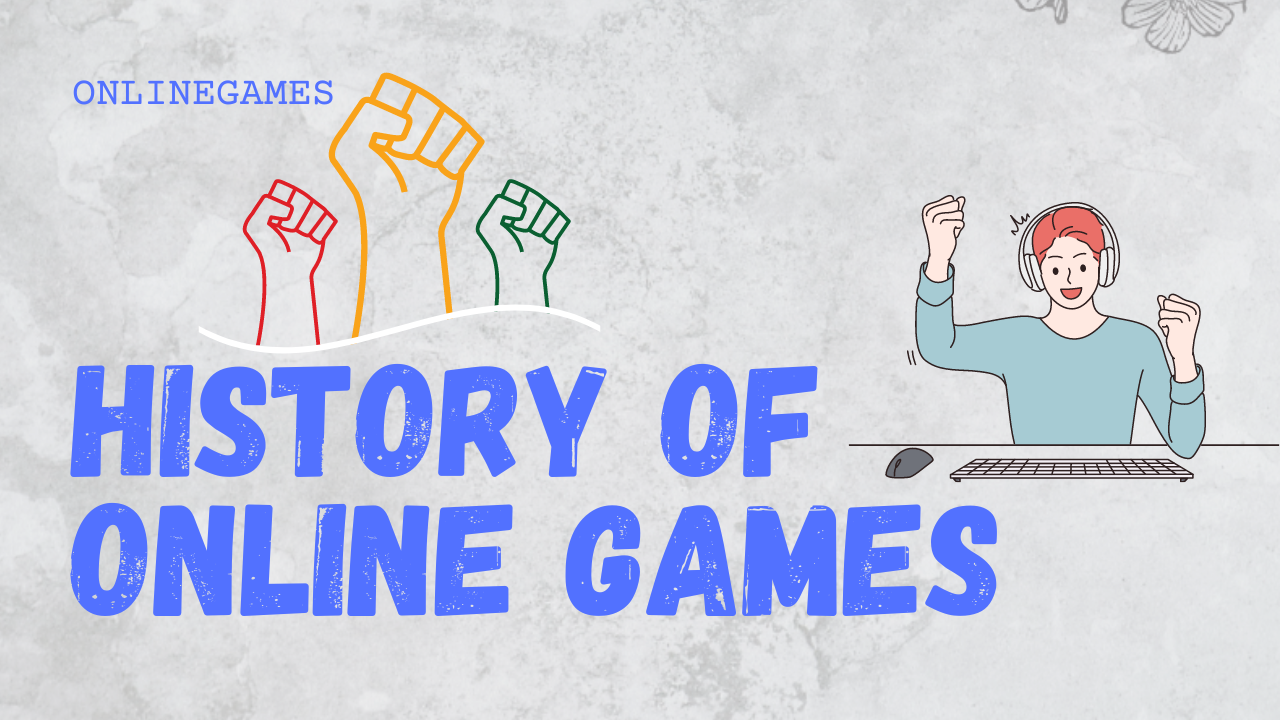The history of online games is a fascinating journey through time, marked by technological advancements, cultural shifts, and the evolution of entertainment. From simple text-based games on mainframes to the complex virtual worlds of today, online games have significantly shaped the way we play and interact with each other. This article explores the development of online games, their milestones, and their impact on society.
Early Beginnings: 1950s to 1970s
The Dawn of Computer Games
The roots of online gaming can be traced back to the 1950s and 1960s, a period when computers were primarily used for research and computation. During this time, a few pioneering individuals began experimenting with using computers for entertainment.
- 1958 – Tennis for Two: One of the earliest examples of a computer game was “Tennis for Two,” created by physicist William Higinbotham. Displayed on an oscilloscope, it simulated a tennis match and allowed two players to compete against each other.
- 1962 – Spacewar!: Another significant milestone was “Spacewar!,” developed by Steve Russell and his team at MIT. This game, designed for the PDP-1 minicomputer, featured two players controlling spaceships engaged in a dogfight, marking one of the first instances of multiplayer gaming.
Mainframe Games and the Birth of Networking
The 1970s saw the advent of networking technology, which enabled computers to communicate with each other. This laid the foundation for the development of online games.
- 1970 – ARPANET and Maze War: The ARPANET, the precursor to the modern internet, became operational in 1969. In 1973, a game called “Maze War” was developed for the Imlac PDS-1 computer. This game allowed players on different machines to connect and compete in a 3D maze, making it one of the earliest examples of networked multiplayer gaming.
The Rise of Networked Games: 1980s
Early Online Games and Bulletin Board Systems (BBS)
The 1980s marked the rise of personal computers and the proliferation of Bulletin Board Systems (BBS), which provided a platform for early online games.
- 1983 – MUD1: The first Multi-User Dungeon (MUD) game, known as MUD1, was developed by Roy Trubshaw and Richard Bartle at the University of Essex. MUDs were text-based adventure games where multiple players could interact in a shared virtual world, setting the stage for future online role-playing games.
- 1985 – CompuServe and the Island of Kesmai: CompuServe, one of the first major online service providers, introduced “The Island of Kesmai,” an early graphical multiplayer game. Players could explore dungeons, fight monsters, and interact with others in a shared environment.
The Emergence of MMORPGs
The concept of Massively Multiplayer Online Role-Playing Games (MMORPGs) began to take shape in the late 1980s, with developers exploring ways to create larger, more immersive online worlds.
- 1986 – Habitat: Developed by Lucasfilm Games and Quantum Link, “Habitat” was one of the first graphical virtual worlds. Players could create avatars, explore different areas, and interact with other players, laying the groundwork for future MMORPGs.
- 1989 – The Sierra Network and The Shadow of Yserbius: The Sierra Network (TSN) launched in 1989, offering a variety of online games, including “The Shadow of Yserbius,” one of the first graphical MMORPGs.
The Internet Age: 1990s
The World Wide Web and Online Gaming
The 1990s saw the commercialization of the Internet and the birth of the World Wide Web, which revolutionized online gaming by providing a global platform for connectivity.
- 1991 – Neverwinter Nights: Developed by AOL and Strategic Simulations, Inc., “Neverwinter Nights” was the first graphical MMORPG to run on the internet. It allowed thousands of players to explore a shared world, complete quests, and engage in combat.
- 1996 – Meridian 59: Often considered the first modern MMORPG, “Meridian 59” was developed by Archetype Interactive and later acquired by 3DO. It featured a 3D world, real-time combat, and a subscription model, setting a new standard for online games.
The Golden Age of MMORPGs
The late 1990s and early 2000s are often referred to as the golden age of MMORPGs, with several iconic games launching during this period.
- 1997 – Ultima Online: Developed by Origin Systems, “Ultima Online” was a groundbreaking MMORPG that introduced a persistent world, player housing, and complex social dynamics. It quickly became one of the most popular online games of its time.
- 1999 – EverQuest: “EverQuest,” developed by Sony Online Entertainment, built on the success of “Ultima Online” by offering a rich 3D world, extensive lore, and a robust community. It set new standards for MMORPGs and inspired numerous other games in the genre.
The Modern Era: 2000s to Present
The Rise of Free-to-Play and Browser Games
The 2000s saw a shift towards free-to-play models and browser-based games, making online gaming more accessible to a wider audience.
- 2003 – RuneScape: “RuneScape,” developed by Jagex, was one of the first successful browser-based MMORPGs. It offered a large, free-to-play world with optional membership for additional content, attracting millions of players.
- 2004 – World of Warcraft: Blizzard Entertainment’s “World of Warcraft” (WoW) launched in 2004 and quickly became the most popular MMORPG in the world. WoW’s polished gameplay, extensive content, and vibrant community set new records and redefined the MMORPG genre.
The Growth of eSports and Competitive Gaming
The 2010s witnessed the explosive growth of eSports, with competitive gaming becoming a major industry.
- 2010 – StarCraft II: “StarCraft II,” developed by Blizzard Entertainment, became a cornerstone of the eSports scene, with professional tournaments and a dedicated fanbase.
- 2011 – League of Legends: Riot Games “League of Legends” (LoL) emerged as a leading eSports title, attracting millions of players and viewers. LoL’s competitive scene includes international tournaments and a robust professional ecosystem.
The Rise of Mobile and Cloud Gaming
The advent of smartphones and cloud gaming services has further expanded the reach of online games, allowing players to enjoy gaming on the go and across different devices.
- 2012 – Clash of Clans: Supercell’s “Clash of Clans” became a global phenomenon, showcasing the potential of mobile games to reach massive audiences and generate significant revenue.
- 2019 – Google Stadia: Google launched Stadia, a cloud gaming service that allows players to stream games over the internet, eliminating the need for high-end hardware and broadening access to online games.
Impact on Society
Cultural Influence
Online games have had a profound impact on culture, influencing everything from social interactions to popular media. They have become a major form of entertainment and a medium for storytelling, art, and community building.
Economic Contributions
The online gaming industry has grown into a multi-billion dollar market, driving economic activity through game sales, in-game purchases, and advertising. It has also created numerous job opportunities in game development, marketing, and eSports.
Technological Advancements
The development of online games has spurred advancements in technology, including networking, graphics, and artificial intelligence. These innovations have not only enhanced gaming experiences but also contributed to broader technological progress.
The history of online games is a testament to the power of technology and creativity in transforming entertainment. From humble beginnings on mainframes to the complex, interconnected worlds of today, online games have continually pushed the boundaries of what is possible. As technology continues to evolve, the future of online gaming promises even more exciting innovations and experiences.










